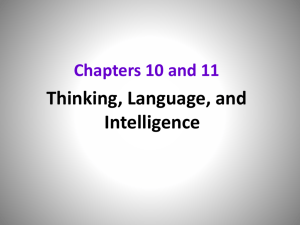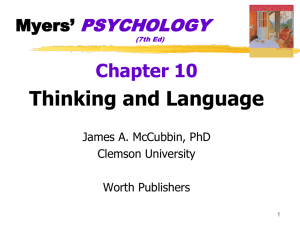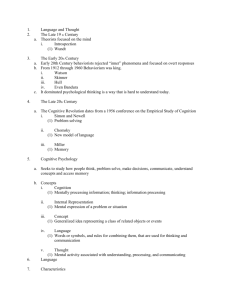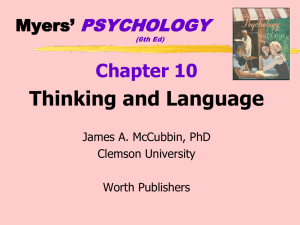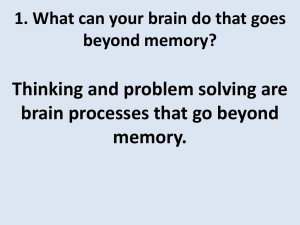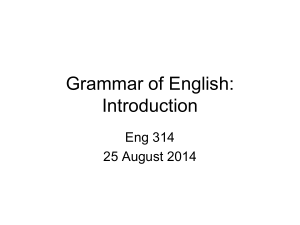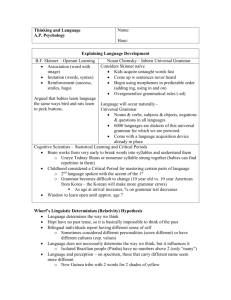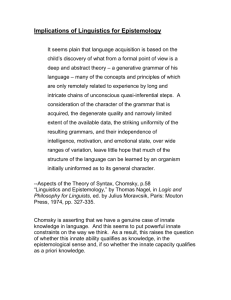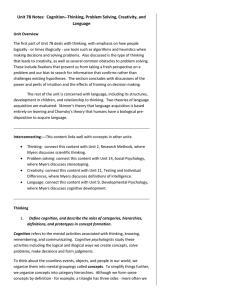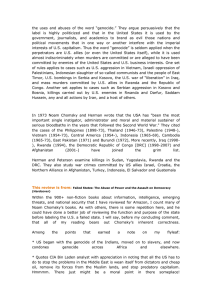Introduction to Psychology
advertisement
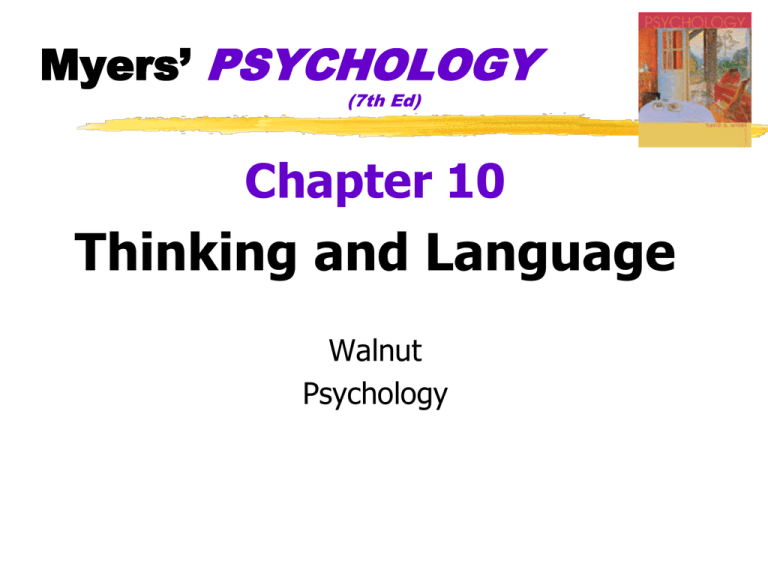
Myers’ PSYCHOLOGY (7th Ed) Chapter 10 Thinking and Language Walnut Psychology Fact or Falsehood? 1.) We notice evidence that contradicts our beliefs more readily than evidence that is consistent with them. 2.) In general, people underestimate how much they really know. 3.) It takes less compelling evidence to change our beliefs than it did to create them in the first place. 4.) Some computers are able to learn from experience. 5.) Only human beings seem capable of insight (the sudden realization of a problem’s solution). The Three-Jugs Problem Using jugs A, B, and C, with the capacities shown, how would you measure out the volumes indicated? The Three-Jugs Problem Solution: a) All seven problems can be solved by the equation shown in (a): B - A - 2C = desired volume. b) But simpler solutions exist for problems 6 and 7, such as A - C for problem 6. Thinking Cognition mental activities associated with thinking, knowing, remembering, and communicating Thinking Concept mental grouping of similar objects, events, ideas, or people Prototype mental image or best example of a category matching new items to the prototype provides a quick and easy method for including items in a category (as when comparing feathered creatures to a prototypical bird, such as a robin) Thinking Algorithm methodical, logical rule or procedure that guarantees solving a particular problem contrasts with the usually speedier–but also more error-prone--use of heuristics Thinking Heuristic simple thinking strategy that often allows us to make judgments and solve problems efficiently usually speedier than algorithms more error-prone than algorithms Thinking Unscramble SPLOYOCHYG Algorithm all 907,208 combinations Heuristic throw out all YY combinations other heuristics? Thinking Insight sudden and often novel realization of the solution to a problem contrasts with strategy-based solutions Confirmation Bias tendency to search for information that confirms one’s preconceptions Fixation inability to see a problem from a new perspective impediment to problem solving Thinking Mental Set tendency to approach a problem in a particular way especially a way that has been successful in the past but may or may not be helpful in solving a new problem The Matchstick Problem How would you arrange six matches to form four equilateral triangles? The Matchstick Problem Solution to the matchstick problem Thinking Functional Fixedness tendency to think of things only in terms of their usual functions impediment to problem solving The Candle-Mounting Problem Using these materials, how would you mount the candle on a bulletin board? The Candle-Mounting Problem Solving this problem requires recognizing that a box need not always serve as a container Heuristics Representativeness Heuristic judging the likelihood of things in terms of how well they seem to represent, or match, particular prototypes may lead one to ignore other relevant information Logic Puzzles A ladder hangs over the side of a ship anchored in a port. The bottom rung touches the water. The distance between rungs is 20 cm and the length of the ladder is 180 cm. The tide is rising at the rate of 15 cm each hour. When will the water reach the seventh rung from the top? I am looking at somebody's photo. Who is it I am looking at, if I don't have any brothers or sisters and the father of the man in the photo is the son of my father? If there are 3 apples and you take away 2, how many do you have? Heuristics Availability Heuristic estimating the likelihood of events based on their availability in memory if instances come readily to mind (perhaps because of their vividness), we presume such events are common Example: airplane crash Thinking Overconfidence tendency to be more confident than correct tendency to overestimate the accuracy of one’s beliefs and judgments Thinking Framing the way an issue is posed how an issue is framed can significantly affect decisions and judgments Example: What is the best way to market ground beef--as 25% fat or 75% lean? Hotel Enigma Three people check into a hotel. They pay $30 to the manager and go to their room. The manager finds out that the room rate is $25 and gives the bellboy $5 to return to the guests. On the way to the room the bellboy reasons that $5 would be difficult to split among three people so he pockets $2 and gives $1 to each person. Now each person paid $10 and got back $1. So they paid $9 each, totaling $27. The bellboy has another $2, adding up to $29. Where is the remaining dollar? Thinking Belief Bias the tendency for one’s preexisting beliefs to distort logical reasoning sometimes by making invalid conclusions seem valid or valid conclusions seem invalid Belief Perseverance clinging to one’s initial conceptions after the basis on which they were formed has been discredited Artificial Intelligence Artificial Intelligence designing and programming computer systems to do intelligent things to simulate human thought processes intuitive reasoning learning understanding language Artificial Intelligence Computer Neural Networks computer circuits that mimic the brain’s interconnected neural cells performing tasks learning to recognize visual patterns learning to recognize smells Language “The limits of your language mean the limits of your world.” Ludwig Wittgenstein Language Language our spoken, written, or gestured works and the way we combine them to communicate meaning Phoneme in a spoken language, the smallest distinctive sound unit Language Morpheme in a language, the smallest unit that carries meaning may be a word or a part of a word (such as a prefix) Grammar a system of rules in a language that enables us to communicate with and understand others Language Semantics the set of rules by which we derive meaning from morphemes, words, and sentences in a given language also, the study of meaning Syntax the rules for combining words into grammatically sensible sentences in a given language Language We are all born to recognize speech sounds from all the world’s languages Percentage able 100 to discriminate 90 Hindi 80 70 60 50 40 30 20 10 0 Hindispeaking adults 6-8 months 8-10 months 10-12 months Infants from English-speaking homes Englishspeaking adults Language Babbling Stage beginning at 3 to 4 months the stage of speech development in which the infant spontaneously utters various sounds at first unrelated to the household language One-Word Stage from about age 1 to 2 the stage in speech development during which a child speaks mostly in single words Language Two-Word Stage beginning about age 2 the stage in speech development during which a child speaks in mostly two-word statements Telegraphic Speech early speech stage in which the child speaks like a telegram-–“go car”--using mostly nouns and verbs and omitting “auxiliary” words Language Summary of Language Development Month (approximate) Stage 4 Babbles many speech sounds. 10 Babbling reveals households language. 12 One-word stage. 24 Two-world, telegraphic speech. 24+ Language develops rapidly into complete sentences. Nature Vs Nurture Noam Chomsky B.F. Skinner « Universal Grammar » Chomsky He found, through his studies, that humans have a « language acquisition device » that other animals do not have. When exposed to language, a child will acquire that language where an animal will not. Thus, a language acquisition device (LAD), as Chomsky calls it, is the function of our brain that allows us to transform exposure to a language into acquisition of grammar. Chomsky argues that the types of grammar that the child needs must be narrowly constrained by human biology. These innate constraints on grammar are what Chomsky refers to as universal grammar, or more commonly known as “language instinct.” Structure-Dependency Knowledge of language requires dependance on the structural relationships within a sentence. By examining changes in a particular sentence, one can see structural relationships within the sentence, and not the linear order of words. Therefore, structure dependancy is a universal principle of language Structure-Dependency A tree diagram representing phrase structure analysis: By examining sentence diagrams, one can see how the elements of a sentence depend on its structure. First Language Acquisition Chomsky developed a theory in opposition to B.F. Skinner, who argued very generally that language comes about as a result of external stimuli. example: a child responds to an object which is acting as a stimulus, for example a doll, calling it « doll. » Chomsky challenges this with the notion of creativity: if a child can regularly produce sentences they have never heard before, how could they be acting through stimuli? Language is not controlled by stimuli. Poverty of the stimulus The source of language must be within the mind itself In other words, a child could not have acquired language from the relatively few samples of language available to the child. This explains the complexity of our knowledge of language, as compared to the poverty of data at a learner’s disposal. Second Language Acquisition Grammatical explanation: one does not learn the grammatical structure of a second language through explicit explanation and instruction Is it possible to become fluent in a second language? According to Chomsky, yes. But motivation plays a big factor. He once gave an example of his two children. He went to Italy once for a few months, and his young boy picked up the language without even trying. However, his older daughter, who was highly motivated to learn Italian, had to work hard at it. Poverty of the stimulus does exist in a second language, according to Chomsky. One cannot truly teach language but can only present conditions for the learner to develop it in his or her own mind. Language Genes design the mechanisms for a language, and experience activates them as it modifies the brain Language Percentage correct on grammar test New language learning gets harder with age 100 90 80 70 60 50 Native 3-7 8-10 11-15 17-39 Age at school Language Linguistic Determinism Whorf’s hypothesis that language determines the way we think Language The interplay of thought and language Animal Thinking and Language Is this really language? Animal Thinking and Language Direction of nectar source The straight-line part of the dance points in the direction of a nectar source, relative to the sun Animal Thinking and Language Gestured Communication

